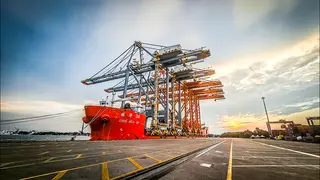The Indian supply chain landscape is all set to undergo a sea change after the new Goods and Services Tax (GST) regime replaces the existing tax structure by October 2012 or latest by April 2013.
Experts feel that the new tax regime will compress the current supply chain structure and could thus water down logistics costs for companies across different sectors. Another possibility that could emerge is the concept of shared logistics infrastructure, such as warehouses, which would sharpen efficiencies.
Companies have already begun to re-map their supply chain structure so as to get optimum tax savings under the new regime.
The tentative decisions on the proposed framework essentially involves introduction of dual GST enabling the Centre and States to simultaneously with a proposed rate of 16 per cent for services and 12-20 per cent for goods.
It was first proposed by the Union Government in 2006-07.
“Historically, tax structures have been a major platform for designing of supply chains. While procurement has been influenced by import duties and availability of input tax credits, distribution has been multi-tiered, influenced by the State boundaries due to CST implications. Now, supply chain designed purely on business parameters will unlock considerable values,” says Mr Prashant Raizada, Director, Tax Advisory Services of BDO Consulting.
Warehousing
One aspect in the current supply chain system that may see major changes is warehousing.
With the GST regime proposing to levy tax on stock transfers and providing full credit on inter-State transactions, it would de-link decisions on warehousing from tax considerations. “Warehouses may no longer be State specific and a warehouse can supply to more than one State. There is a possibility of lowering cost of operations due to compression of the supply chain and uniformity in sourcing decisions,” Mr Nitin Goyal, Sr Tax Advisory Services of BDO Consulting, told Business Line .
A recent KPMG study on impact of GST on Transportation and Logistics Industry has also pointed out the new scenario could involve lesser number of warehouses, but with larger sizes.
“This would translate into expansion of some of the existing warehouses, development of new ones and shutting down of several existing facilities,” it pointed out.
Analysts see a distinct possibility of primary freight rates could soften in the wake of re-organised nationwide networks, since warehouses would now be preferred to be located in closer proximity of manufacturing sites.
The other changes that would emerge under the new tax regime include more flexibility in vendor selection, as location will no longer be a constraint, reduction in procurement cost, rationalisation of stocking/distribution points and flexibility of differential pricing policy.
Petro products
However, analysts feel that one area that needed a re-look is the proposal to keep petroleum products and natural gas out of the ambit of GST.
This could have major implications on the transportation sector, where motor spirits accounts for almost 60 per cent of the cost component.
“Exclusion of petroleum products from GST will break the chain of credits, thus adding to the costs. Petroleum products should form part of the GST regime, albeit with a higher tax rate,” the KPMG study suggests. One sector that would benefit from the new regime will be organised logistics service providers.
Today, reports indicate that the 10-odd leading players have a market share of less than 5 per cent.
The new regime could see the emergence of new players in the organised sector as taxes will not be added costs for businesses.
Fourth Party Logistics
Further, the Fourth Party Logistics (4PL) industry, which is in its early stages of growth in India, could also get a significant boost after the implementation of GST.
The important question facing corporates right now is how to get ready for GST.
For, it is imperative that business houses start re-working their supply chain routes right away, as re-structuring and consolidation takes time.
“I think companies should set up a GST steering committee to understand the complete ramifications of the GST and suggest a road map to gain maximum economic and operational mileage,” Mr Nitin Goyal feels.
An important constituent in the new road map will be a bigger dose of IT that will now be required in areas such as documentation, accounting procedures, Enterprise Resource Planning and warehouse management systems.








Comments
Comments have to be in English, and in full sentences. They cannot be abusive or personal. Please abide by our community guidelines for posting your comments.
We have migrated to a new commenting platform. If you are already a registered user of TheHindu Businessline and logged in, you may continue to engage with our articles. If you do not have an account please register and login to post comments. Users can access their older comments by logging into their accounts on Vuukle.